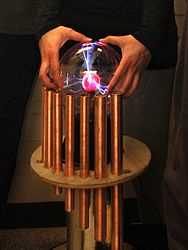Viola organista

The viola organista is an experimental musical instrument designed by Leonardo da Vinci. It uses a friction belt to vibrate individual strings (similar to how a violin produces sounds), with the strings selected by pressing keys on a keyboard (similar to an organ). The first known implementations made from Leonardo's incomplete designs were in modern times.
Description
Leonardo designed many different and elaborate models of viola organista, as preserved in his notebooks of 1488–1489 and in the drawings in the Codex Atlanticus and Manuscript H.[1]
In the first model the friction of the strings was achieved by a mechanical bow traveling sideways. The second model featured a single rotating wheel, similar to that of the earlier hurdy-gurdy, to play strings. It differs in that a hurdy-gurdy has a small number of strings that are constantly in contact with the wheel, rather than a larger number of strings that can be lowered onto the wheel. A hurdy-gurdy has a keybox with tangents that change the pitches of the strings, rather like placing fingers on violin strings. Leonardo's innovation of a keyboard with a lowering mechanism allowed individual notes to be played, alone or in specific desired chords over a large range of pitches.
Both the mechanical bow and the rotating wheel concepts were abandoned in favor of a third and final model. The main idea of this design was to use one or more wheels, continuously rotating, each of which pulled a looping bow, rather like a fanbelt in an automobile engine, and perpendicular to the instrument's strings. The strings would be pushed downward into the bow by the action of the keys, causing the moving bow to sound the pitch of the string. In one design, the strings were fretted with tangents, so that there were more keys than strings (multiple notes, for example C and C#, would be played on one string). In another design, each note had its own string.
History
It is not known if Leonardo ever built a working prototype of this instrument. The first similar instrument actually to be constructed was the Geigenwerk of 1575 by Hans Heyden, a German instrument inventor. However, Geigenwerk is not based on Leonardo's designs and it uses several friction wheels instead of a friction belt to vibrate the strings.[2]
A few instrument builders have created modern reconstructions of Geigenwerk but calling them viola organista.
Akio Obuchi built several instruments as early as 1993.[3] In 2004, one of them was used in a concert in Genoa, Italy .
In 2013, Sławomir Zubrzycki finished construction and performed on his instrument[4] at the Academy of Music in Kraków.
Sources and further reading
- Carolyn W. Simons, "Sostenente piano", and Emanuel Winternitz and Laurence Libin, "Leonardo da Vinci," Grove Music Online ed. L. Macy (Accessed April 2, 2005 at www.grovemusic.com), (subscription access)
- "Sostenente piano", The New Harvard Dictionary of Music, ed. Don Randel. Cambridge, Massachusetts, Harvard University Press, 1986. ISBN 0-674-61525-5
References
- ↑ Winternitz, Emanuel (1982). Leonardo Da Vinci As a Musician.
- ↑ Winternitz, Emanuel (1982). Leonardo Da Vinci As a Musician.
- ↑ http://obuchi.music.coocan.jp/index-e.htm
- ↑ The Da Vinci Tone
External links
- Akio Obuchi's reconstruction as used in Genoa
- Polish musician creates replica of Da Vinci's 'viola organista'
- Viola organista made by Sławomir Zubrzycki
| ||||||||||||||||||||||||||||||||||||||||||||||
| ||||||||||||||||||||||||||||||||||||||
